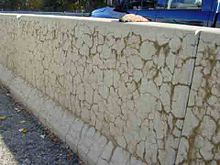- Concrete step barrier
-
A concrete step barrier is a safety barrier used on the central reservation of motorways and dual carriageways as an alternative to the standard steel crash barrier.
The barrier has contained all vehicles up to 13.5 tonnes.[1]
Contents
United Kingdom
With effect from January 2005 and based primarily on safety grounds, the UK Highways Agency policy is that all new motorway schemes are to use high-containment concrete barriers in the central reserve. All existing motorways will introduce concrete barriers into the central reserve as part of ongoing upgrades and through replacement when these systems have reached the end of their useful life. This change of policy applies only to barriers in the central reserve of high-speed roads and not to verge-side barriers. Other routes will continue to use steel barriers.[1] Government policy ensures that all future crash barriers in the UK will be made of concrete unless there are overriding circumstances.[2]
Ireland
The usage of the concrete step barrier has now become widespread in Ireland. As of November 2008, 405 kilometres (252 mi) of new motorway under construction at present will use the new barrier. Existing motorways such as parts of the M8 and M6 already have the crash barrier. Other motorways are now installing them as part of upgrades (M50).
Degradation processes
 Typical crack pattern associated with the alkali-silica reaction affecting a Jersey barrier on a US highway (photograph, courtesy of the Federal Highway Administration (US Department of Transportation).
Typical crack pattern associated with the alkali-silica reaction affecting a Jersey barrier on a US highway (photograph, courtesy of the Federal Highway Administration (US Department of Transportation).
Various types of aggregate may undergo chemical reactions in concrete, leading to damaging expansive phenomena. The most common are those containing reactive silica, that can react with the alkalis in concrete. Amorphous silica is one of the most reactive mineral components in some aggregates containing e.g., opal, chalcedony, flint. Following the alkali-silica reaction (ASR), an expansive gel forms, that creates extensive cracks and damage on structural members.
See also
- Jersey barrier
- Constant slope barrier
- F-shape barrier
- Road-traffic safety
References
- ^ a b "Interim Advice Note 60/05" (PDF). Highways Agency. 20 January 2005. http://www.standardsforhighways.co.uk/ians/pdfs/ian60.pdf. Retrieved 2008-12-30.
- ^ "Written Answers to Questions". Hansard. 8 November 2005. http://www.publications.parliament.uk/pa/cm200506/cmhansrd/vo051108/text/51108w02.htm. Retrieved 2008-12-30.
Categories:- Road safety
- Safety equipment
- Concrete
Wikimedia Foundation. 2010.



